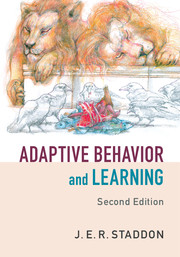Book contents
- Frontmatter
- Contents
- Preface to the second edition
- Acknowledgments
- 1 The evolution, development, and modification of behavior
- 2 Variation and selection: kineses
- 3 Reflexes
- 4 Direct orientation and feedback
- 5 Operant behavior
- 6 Reward and punishment
- 7 Feeding regulation: a model motivational system
- 8 The optimal allocation of behavior
- 9 Choice: dynamics and decision rules
- 10 Foraging and behavioral ecology
- 11 Stimulus control and cognition
- 12 Stimulus control and performance
- 13 Molar laws
- 14 Time and memory, I
- 15 Time and memory, II
- 16 Template learning
- 17 Learning, I
- 18 Models of classical conditioning
- 19 Learning, II
- 20 Learning, III: procedures
- 21 Comparative cognition
- Index
4 - Direct orientation and feedback
Published online by Cambridge University Press: 05 March 2016
- Frontmatter
- Contents
- Preface to the second edition
- Acknowledgments
- 1 The evolution, development, and modification of behavior
- 2 Variation and selection: kineses
- 3 Reflexes
- 4 Direct orientation and feedback
- 5 Operant behavior
- 6 Reward and punishment
- 7 Feeding regulation: a model motivational system
- 8 The optimal allocation of behavior
- 9 Choice: dynamics and decision rules
- 10 Foraging and behavioral ecology
- 11 Stimulus control and cognition
- 12 Stimulus control and performance
- 13 Molar laws
- 14 Time and memory, I
- 15 Time and memory, II
- 16 Template learning
- 17 Learning, I
- 18 Models of classical conditioning
- 19 Learning, II
- 20 Learning, III: procedures
- 21 Comparative cognition
- Index
Summary
Indirect orientation – kinesis – works by means of successive comparisons. Animals orient in this way either when the gradient to be detected is too shallow to permit simultaneous comparison or when the source of stimulation cannot be sensed at a distance because the direction of local gradients is not perfectly related to the direction of the source. Visual and auditory stimuli allow for a more efficient strategy: The local gradient always points to the source, and gradients are usually quite steep. Thus, simultaneous comparisons can provide immediate feedback about the proper direction of movement, allowing direct orientation with no wasted motion.
I next discuss simple mechanisms of direct orientation, first in a descriptive way, and then in terms of feedback mechanisms. The feedback discussion serves several purposes: It shows how feedback is involved in orientation, and how a mathematical model can account for experimental results. It shows how apparently different orientation reactions can be considered as variants of the same process. And it illustrates the difference between static and dynamic behavior theories. The remainder of the chapter discusses the type of explanation given by feedback accounts and shows how the concept of feedback control provides a mechanistic explanation for motive and purpose.
Taxes
Fraenkel and Gunn classify direct orientation (taxic) reactions into four main types. These do not, in fact, correspond to completely different mechanisms, but the mechanisms will be easier to understand after I describe the different types and the experiments used to tell one from the other.
Klinotaxis
The first taxic reaction, klinotaxis, is really an intermediate case, since it involves both direct orientation and successive comparisons like kineses. Figure 4.1 shows an example of the relevant behavior: Mast tested each of four maggots (Lucilia sericata) four to six times for its orientation to a horizontal beam of light. Movement was always directly away from the light, although the tracks are not perfectly smooth. The maggots, particularly individual A on the right, move their heads from side to side (wiggles in the record). These head movements provide a clue to the underlying process. Fraenkel and Gunn write: “During steady forward crawling the head is sometimes put down symmetrically in line with the axis of the body, but from time to time it comes down alternately to the right and to the left.
Information
- Type
- Chapter
- Information
- Adaptive Behavior and Learning , pp. 67 - 101Publisher: Cambridge University PressPrint publication year: 2016
